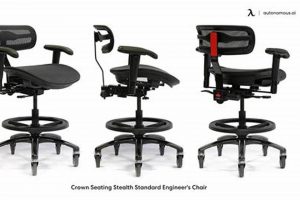A method for analyzing the efficiency of work processes involves observing and recording the time taken to complete each element of a task. This systematic evaluation breaks down a job into its constituent motions, allowing for precise measurement of the duration of each movement. The data gathered is then used to identify and eliminate unnecessary or inefficient steps, thereby streamlining the overall operation. For example, in an assembly line setting, this technique could be used to meticulously assess the time required for each worker to attach a specific component, revealing opportunities for optimization.
The value of this approach lies in its potential to enhance productivity, reduce costs, and improve worker ergonomics. By identifying and removing wasted effort, organizations can achieve significant gains in output and profitability. Historically, this analytical technique has been instrumental in the development of efficient manufacturing processes and has contributed significantly to advancements in fields ranging from factory work to office administration. Its application can lead to a more standardized and optimized workflow, ultimately benefiting both the employer and the employee.
The subsequent sections of this document will delve into the specific techniques employed in this methodology, explore relevant case studies demonstrating its practical application, and examine the role of technology in facilitating its implementation. A critical analysis of potential limitations and ethical considerations associated with this practice will also be presented.
Time and Motion Study
Effective application of time and motion study requires a structured approach and meticulous attention to detail. The following guidelines will assist in maximizing the benefits derived from its implementation.
Tip 1: Clearly Define Objectives: Before commencing any analysis, explicitly state the goals to be achieved. Whether the aim is to reduce cycle time, improve ergonomics, or increase throughput, a well-defined objective provides focus and direction.
Tip 2: Select Representative Subjects: The individuals observed should be competent and representative of the typical workforce performing the task. Avoid selecting exceptionally skilled or unskilled workers, as this may skew the results.
Tip 3: Document Existing Methods: Thoroughly document the current procedures being employed. This provides a baseline against which improvements can be measured and ensures that any changes are properly understood.
Tip 4: Break Down Tasks into Elements: Decompose each job into its fundamental motions or steps. This granular analysis facilitates the identification of inefficiencies and areas for optimization. For example, assembly tasks can be segmented into components like “reach for part,” “grasp part,” and “position part.”
Tip 5: Use Standardized Measurement Techniques: Employ consistent and reliable methods for measuring time, such as stopwatches or video analysis software. Ensure that all measurements are accurate and verifiable.
Tip 6: Analyze Data Objectively: Interpret the collected data in an unbiased manner, focusing on identifying areas where improvements can be made. Avoid making assumptions or drawing conclusions based on limited information.
Tip 7: Implement and Test Improvements: Introduce changes incrementally and systematically, carefully monitoring their impact on overall performance. Conduct trials to validate the effectiveness of any proposed modifications.
Tip 8: Continuously Monitor and Refine: Time and motion study is not a one-time event. Regularly review and update the analysis to adapt to changing conditions, new technologies, or evolving business needs.
Adherence to these guidelines will facilitate the effective use of this methodology for optimizing work processes, improving productivity, and enhancing overall operational efficiency. The systematic elimination of wasted effort and the careful refinement of work methods ultimately contributes to a more streamlined and cost-effective enterprise.
The subsequent discussion will explore case studies illustrating the successful application of these techniques in various industries.
1. Efficiency Measurement
Efficiency measurement serves as the cornerstone for evaluating and improving productivity within any organization. Its profound connection to time and motion study makes it indispensable for identifying areas of operational waste and optimizing work processes. By systematically quantifying the resources consumed relative to the output achieved, businesses can make informed decisions regarding resource allocation and workflow design.
- Quantifying Work Cycle Time
Efficiency measurement, when integrated with time and motion study, enables precise quantification of work cycle times. The duration required to complete each task or element of a job is meticulously recorded, providing a baseline for identifying areas of delay or redundancy. For example, measuring the time required for a manufacturing worker to assemble a component allows for comparison against established standards, highlighting potential bottlenecks in the production line.
- Identifying Non-Value-Added Activities
A key aspect of efficiency measurement within the context of time and motion study is the identification of non-value-added activities. These are tasks that consume resources without contributing directly to the final product or service. Through detailed observation and measurement, activities such as unnecessary movement, excessive waiting times, or redundant inspections can be pinpointed and subsequently eliminated or minimized. This reduction in non-value-added activities directly contributes to improved overall efficiency.
- Establishing Performance Standards
Efficiency measurement facilitates the establishment of performance standards for specific tasks. By analyzing the time required by proficient workers to complete a given job, realistic benchmarks can be set for other employees. These standards serve as targets for improvement and provide a basis for performance evaluation. Furthermore, consistent application of these standards contributes to a more standardized and predictable workflow.
- Monitoring Productivity Trends
Continuous efficiency measurement, informed by time and motion study data, allows organizations to monitor productivity trends over time. By tracking key performance indicators (KPIs) such as output per worker-hour or cycle time reduction, businesses can assess the impact of implemented improvements and identify areas requiring further attention. This ongoing monitoring ensures that efficiency gains are sustained and that resources are allocated effectively to drive continuous improvement.
In conclusion, efficiency measurement and time and motion study form a synergistic relationship, where detailed analysis of work processes enables the quantification of efficiency gains and identification of areas for optimization. The data derived from these studies provides a solid foundation for informed decision-making and continuous improvement initiatives, ultimately leading to enhanced productivity and competitiveness.
2. Motion economy
Motion economy, as a principle, is intrinsically linked to time in motion study. It represents a systematic approach to optimizing work processes by minimizing unnecessary movements and maximizing the efficiency of required actions. Its relevance lies in the direct correlation between reduced motion and decreased task completion time, thus enhancing overall productivity.
- Reduction of Unnecessary Movements
The primary goal of motion economy is to eliminate extraneous motions that do not contribute directly to the completion of a task. This involves analyzing work processes to identify and remove movements that are wasteful, repetitive, or contribute to fatigue. For instance, redesigning a workstation to place tools within easy reach can significantly reduce the time spent reaching and searching for them. This translates directly into time savings documented and validated by time in motion studies.
- Optimizing Workstation Layout
A carefully designed workstation promotes efficiency by minimizing the distance workers must travel to obtain materials or tools. Proper arrangement of components, equipment, and controls allows for a more fluid and natural workflow. A classic example is the layout of an assembly line, where components are positioned in the sequence required for assembly, thereby reducing travel time and improving overall throughput. Time in motion studies validate the effectiveness of alternative layouts by precisely measuring time savings.
- Use of Ergonomic Principles
Motion economy emphasizes the importance of ergonomic principles in the design of work processes. This involves considering the physical capabilities and limitations of workers to minimize strain and fatigue. For instance, using adjustable workstations and providing proper seating can improve posture and reduce the risk of musculoskeletal disorders. Ergonomic improvements not only enhance worker well-being but also lead to increased productivity, as employees are able to perform tasks more efficiently and with fewer interruptions. The resulting increases in efficiency can be quantified by time in motion studies.
- Standardization of Tools and Procedures
Standardizing tools and procedures ensures consistency and reduces the time required to complete tasks. Using the same tools and methods for similar operations eliminates the need for workers to adapt to different setups, thereby minimizing variability and improving efficiency. Standard Operating Procedures (SOPs) developed based on motion economy principles ensure that each task is performed in the most efficient manner possible, as demonstrated by time in motion analyses.
The application of motion economy principles, validated through time in motion studies, is fundamental to improving productivity, reducing costs, and enhancing worker satisfaction. The systematic elimination of unnecessary movements and the optimization of work processes contribute to a more efficient and sustainable operating environment, underlining its ongoing relevance in modern workflow management.
3. Time standardization
Time standardization, in the context of operational efficiency, is inextricably linked to time in motion study. It represents the process of establishing consistent, repeatable time benchmarks for specific tasks or elements within a workflow. Time in motion study provides the empirical foundation for this standardization by meticulously measuring the time required for proficient workers to complete each step. This data-driven approach ensures that the established time standards are based on observed performance rather than arbitrary estimations. For example, if a time in motion study reveals that a skilled operator consistently assembles a component in 2 minutes and 30 seconds, that time becomes the standardized benchmark for that particular task. Without the detailed observation and measurement inherent in time in motion study, time standardization would lack a credible basis and be prone to inaccuracies.
The practical significance of time standardization lies in its ability to facilitate performance monitoring, resource allocation, and process control. Standardized times enable managers to accurately assess worker productivity, identify bottlenecks in the workflow, and allocate resources effectively. For instance, if a worker consistently fails to meet the established time standard for a particular task, it signals a potential problem, such as inadequate training, equipment malfunction, or process inefficiency. By addressing these issues, organizations can improve overall productivity and reduce costs. Moreover, standardized times provide a basis for developing accurate cost estimates and pricing strategies. The ability to predict the time required for various operations allows businesses to make informed decisions regarding labor costs and production schedules.
In conclusion, time standardization is a critical component of effective workflow management, and time in motion study provides the essential data required to establish credible and reliable time standards. The benefits of this integrated approach include improved performance monitoring, optimized resource allocation, and enhanced process control. The ongoing refinement of standardized times, informed by continuous time in motion studies, ensures that organizations can adapt to changing conditions and maintain a competitive edge. Challenges in implementation may arise from resistance to measurement or variability in worker skill; however, these can be mitigated through transparent communication and comprehensive training programs.
4. Process Optimization
Process optimization is inextricably linked to time in motion study; it represents a systematic effort to refine workflows for maximum efficiency and effectiveness. Time in motion study serves as the analytical engine driving process optimization, providing the detailed data necessary to identify areas for improvement. The core principle is that by meticulously observing and measuring the time required for each component of a process, inefficiencies and redundancies can be pinpointed and subsequently addressed. The cause-and-effect relationship is clear: time in motion study provides the data, and process optimization utilizes that data to enact changes. For example, in a manufacturing plant, time in motion study might reveal that a particular assembly step is consistently taking longer than anticipated. This discovery would then trigger an investigation into the causes of the delay, leading to process changes such as equipment modifications, worker training, or workstation redesign. Process optimization is not merely a consequence of time in motion study; it is an integral component, representing the action phase where insights are translated into practical improvements.
Further illustrating the practical significance of this connection, consider the case of a healthcare clinic analyzing patient intake procedures. Time in motion study could be employed to measure the time spent on each step, from initial check-in to vital sign measurement. This analysis might reveal that patients are spending an excessive amount of time waiting in the reception area. Process optimization, informed by this data, could then lead to the implementation of changes such as online pre-registration, streamlined paperwork, or modified staffing levels to reduce waiting times. In a service industry context, a call center could utilize time in motion studies to assess the efficiency of customer service representatives. The study might indicate that certain scripts or procedures are leading to longer call times. Process optimization, following this analysis, could involve revising the scripts, providing additional training to the representatives, or implementing automated systems to handle routine inquiries. The key is that process optimization is not a theoretical exercise but a data-driven approach to achieving tangible improvements in real-world scenarios.
In summary, time in motion study and process optimization are mutually reinforcing activities. Time in motion study provides the granular data required to identify inefficiencies, while process optimization utilizes that data to implement targeted improvements. The practical significance of this understanding is evident in various sectors, from manufacturing to healthcare and customer service. While challenges may arise in accurately measuring time or in securing buy-in from stakeholders, the potential benefits of increased efficiency, reduced costs, and improved service quality make this integrated approach essential for organizations seeking to optimize their operations.
5. Ergonomic improvements
Ergonomic improvements and time in motion study are closely intertwined, representing a synergistic approach to optimizing work environments and processes. Time in motion study provides the analytical foundation for identifying ergonomic deficiencies, while ergonomic improvements serve as a targeted intervention to address these issues, leading to enhanced worker well-being and increased productivity. The connection is one of cause and effect: inefficient or uncomfortable movements, identified through time in motion study, are addressed through ergonomic design principles, resulting in measurable improvements in both efficiency and worker comfort. Ergonomic considerations are not merely ancillary to time in motion study; they represent an essential component of a holistic approach to workflow optimization. As an illustrative example, time in motion studies might reveal that workers in a packaging plant are expending excessive energy reaching for boxes, leading to fatigue and reduced output. Ergonomic improvements, such as repositioning the boxes closer to the workstation or providing adjustable-height platforms, can reduce strain and improve efficiency, quantifiable through subsequent time in motion studies.
The practical significance of this understanding extends beyond individual task optimization. When ergonomic principles are integrated into time in motion studies, it fosters a proactive approach to preventing musculoskeletal disorders and promoting a healthier work environment. For instance, an office setting may appear superficially efficient; however, time in motion study coupled with ergonomic assessment might reveal that employees are spending prolonged periods in awkward postures, leading to discomfort and potential long-term health issues. Implementing ergonomic improvements such as adjustable chairs, monitor arms, and keyboard trays can mitigate these risks, improving employee comfort, reducing absenteeism, and enhancing overall productivity. Furthermore, in assembly line environments, ergonomic improvements often involve redesigning workstations to minimize repetitive motions and awkward postures, reducing the risk of repetitive strain injuries. Time in motion studies can then validate the effectiveness of these ergonomic interventions by measuring reductions in task completion time and improvements in worker comfort levels.
In summary, ergonomic improvements and time in motion study form a critical partnership in enhancing both the efficiency and the well-being of workers. The detailed data derived from time in motion studies provides a basis for implementing targeted ergonomic interventions, while the resulting improvements are quantifiable through subsequent time studies. While challenges may exist in integrating these two disciplines, such as the need for specialized expertise and the potential for resistance to change, the long-term benefits of a healthier, more productive workforce make this integrated approach essential for organizations committed to optimizing their operations and fostering a positive work environment.
6. Productivity enhancement
Productivity enhancement is a primary objective of time in motion study, functioning as the desired outcome of the analytical process. The application of time in motion study directly aims to increase the volume of output achieved per unit of input, whether measured in labor hours, materials, or capital investment. Consequently, this connection is fundamental: time in motion study identifies inefficiencies, and the elimination of those inefficiencies directly results in productivity gains. An assembly line, for instance, undergoes time in motion analysis to pinpoint bottlenecks or unnecessary movements. Eliminating these inefficiencies, often through workstation redesign or process modification, demonstrably increases the number of units assembled per worker per hour, thus enhancing productivity. The data from the study provides the basis for informed decision-making and targeted intervention.
Further examples of this connection manifest in various industries. In a warehouse setting, time in motion study can analyze the picking and packing process. Streamlining the route a worker takes to retrieve items, or optimizing the packaging procedure, directly translates to more orders fulfilled per day. Similarly, in a customer service center, analyzing the time spent on each call and identifying common sources of delay, can lead to improved training programs or revised scripts, enabling representatives to handle more calls per hour. These enhancements, driven by time in motion insights, demonstrate the tangible link between process analysis and productivity improvement. The quantification of productivity gains becomes a key performance indicator (KPI), demonstrating the Return On Investment (ROI) for the time and effort dedicated to this analysis. The enhancement is measurable and repeatable.
In conclusion, productivity enhancement is not merely a potential byproduct of time in motion study, but rather its central purpose. The systematic analysis of workflows, coupled with the implementation of data-driven improvements, directly contributes to increased output, reduced costs, and improved overall efficiency. Challenges may arise in accurately measuring and interpreting the data, or in gaining buy-in from employees who may perceive the process as intrusive. However, the potential for significant productivity gains makes the application of time in motion study a valuable tool for organizations seeking to optimize their operations and maintain a competitive advantage. The practice requires careful planning, execution, and communication to realize its potential.
7. Waste reduction
Waste reduction and time in motion study exhibit a strong, direct correlation. Time in motion study, through its detailed analysis of work processes, identifies inefficiencies that often manifest as various forms of waste. These include wasted time due to unnecessary movements, wasted effort due to poor ergonomics, and wasted resources due to inefficient procedures. Waste reduction, then, becomes a logical outcome of applying the principles of time in motion study. A manufacturing facility using time in motion study may discover that workers are spending an excessive amount of time walking between workstations to retrieve tools. Addressing this wasted movement through improved workstation layout directly reduces the time and energy expended, contributing to a more efficient operation and, ultimately, waste reduction. This underscores the principle that waste reduction is not simply a desired outcome; it is an integral part of the methodology.
The practical significance of this connection extends beyond the shop floor. In an office environment, time in motion study can reveal that employees are wasting time searching for information due to disorganized filing systems. By implementing a more structured information management system, the time spent searching for documents is reduced, leading to waste reduction in the form of improved employee productivity. In a healthcare setting, analyzing the flow of patients through a clinic using time in motion principles can identify wasted time due to inefficient scheduling or poorly designed patient pathways. Addressing these inefficiencies through process improvements directly reduces patient waiting times and enhances the overall efficiency of the clinic, thus reducing waste from idle resources. These examples illustrate how the principles apply across various industries and organizational contexts. Waste reduction and efficiency go hand in hand in this case.
In conclusion, waste reduction is a critical benefit of time in motion study, representing a tangible outcome of the systematic analysis and optimization of work processes. The ability to identify and eliminate wasted time, effort, and resources through this methodology has significant implications for improving organizational efficiency and sustainability. While challenges such as resistance to change or the complexity of certain processes may exist, the potential rewards of waste reduction make time in motion study a valuable tool for organizations committed to continuous improvement and resource conservation. The principles and the results have proven to be effective and have benefited many fields of work.
Frequently Asked Questions Regarding Time in Motion Study
This section addresses common inquiries and clarifies misconceptions surrounding the principles and application of time in motion study. The information provided aims to offer a comprehensive understanding of this analytical technique.
Question 1: What is the core objective of time in motion study?
The primary objective is to analyze the efficiency of work processes by systematically observing and recording the time taken to complete each element of a task. This data is then used to identify and eliminate inefficiencies, optimize workflows, and ultimately enhance productivity.
Question 2: How does time in motion study differ from other process improvement methodologies?
Time in motion study distinguishes itself through its granular focus on individual movements and their associated time durations. This level of detail allows for a precise identification of inefficiencies that might be overlooked by broader process analysis techniques.
Question 3: What are the potential ethical considerations associated with time in motion study?
Ethical considerations revolve around ensuring worker privacy, avoiding undue pressure to increase output, and preventing the use of study results to justify unfair labor practices. Transparency and open communication with employees are crucial to mitigating these concerns.
Question 4: Can time in motion study be applied to non-manufacturing environments?
Yes, the principles of time in motion study are applicable to a wide range of environments, including offices, healthcare facilities, and service industries. The key is to adapt the methodology to the specific characteristics of the work being analyzed.
Question 5: What role does technology play in modern time in motion study?
Technology plays a significant role in facilitating data collection, analysis, and visualization. Video recording, motion capture software, and statistical analysis tools enhance the accuracy and efficiency of the study process.
Question 6: How is time in motion study related to ergonomic improvements?
Time in motion study provides the data necessary to identify ergonomic deficiencies in work processes. By analyzing the movements and postures required to complete tasks, potential sources of strain and discomfort can be identified and addressed through ergonomic design principles.
In essence, time in motion study is a powerful analytical tool when applied ethically and strategically. The insights gained can lead to significant improvements in productivity, efficiency, and worker well-being.
The next section will explore case studies illustrating the practical application of time in motion study across various industries.
Conclusion
The preceding exploration has illuminated the multifaceted nature of time in motion study, demonstrating its value in optimizing work processes across diverse sectors. The detailed analysis, identification of inefficiencies, and subsequent implementation of data-driven improvements represent a systematic approach to enhancing productivity, reducing waste, and improving ergonomic conditions. The methodology’s strength lies in its ability to quantify the time associated with each element of a task, providing a foundation for informed decision-making and targeted intervention.
Continued application of time in motion study, adapted to evolving technological landscapes and mindful of ethical considerations, remains crucial for organizations seeking to maintain a competitive edge. The commitment to ongoing analysis and refinement of work processes ensures a pathway towards sustainable efficiency gains and a more productive, healthier workforce. This structured methodology provides the means by which organizations can systematically improve processes.







